 Wondering what Durban looks like, what its history is, where you might go for a walk in the conference and hotel zones? Ruth Teer-Tomaselli, outgoing IAMCR Vice-President and chair of the Durban Organizing Committee, has photos she took personally for you, and a great deal of fascinating local information. We're very sorry if you are having to miss this conference, but this will give you a sense of your IAMCR colleagues' experience.
Wondering what Durban looks like, what its history is, where you might go for a walk in the conference and hotel zones? Ruth Teer-Tomaselli, outgoing IAMCR Vice-President and chair of the Durban Organizing Committee, has photos she took personally for you, and a great deal of fascinating local information. We're very sorry if you are having to miss this conference, but this will give you a sense of your IAMCR colleagues' experience.
by Ruth Teer-Tomaselli
University of KwaZulu-Natal
On Christmas Day 1497, the Portuguese explorer Vasco da Gama sailed parallel to what is now Durban. He named the countryside ‘Natal’, which is ‘Christmas’ in Portuguese. Of course, da Gama didn’t ‘discover’ Natal any more than Columbus ‘discovered’ America, but he did provide us with the first written record of its existence. The Zulu people, under the might King Shaka (after whom our brand new airport is named), lived along the coast, and remain the largest demographic group in the region. In 1938, a ‘capital town’ was built here, named d’Urban in honour of the governor of the Cape Colony.
The Boers established a Republic in Natal in 1838, and of course, the inevitable happened, the British fought to get the territory back, and make it the Colony of Natal, the Last Outpost of the British Empire. In 1910, the Colony joined the rest of South Africa to become the Union of South Africa. 1898, Indian people were brought in from the Indian subcontinent to work on the cane fields, and three generations later, Durban is still largely Indian; indeed, it is known as the "the largest 'Indian' city outside India".
Nowadays, Durban is the third largest city in South Africa after Johannesburg and Cape Town, with the busiest harbor in Africa and a huge container port. It is part of the giant metropolis named eThekwini – the isiZulu name for Durban – which is translated various as ‘lagoon’ or ‘the one-testicled one’, referring to the appearance of the Durban Bay. Take your pick.
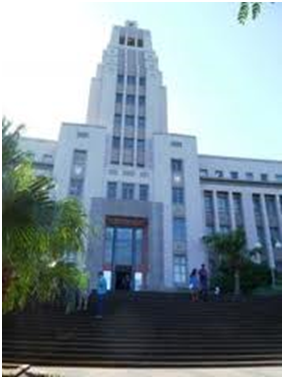 |
| Memorial Tower Block, UKZN. (Photo: UKZN Trust) |
The University of KwaZulu-Natal is the result of the merger of the previous Universities of Natal and Durban-Westville. It is located on five campuses, with the Howard College Campus standing on the top o the Berea (a word that simply means ‘ridge’) overlooking the whole of the city. The top of the Memorial Tower Block, a building dedicated to the memory of those killed in the two World Wars and the location of some of our conference break away rooms, is the highest point in Durban, and can be seen from almost any vantage point in the city.
As a holiday destination, Durban has the great advantage of all-year round warmth and some of the best beaches in the world – kilometres of white, clean sand, enhanced by the recent makeover of the entire beach front. The three main hotels, at which delegates are staying, are on directly on this beachfront. I love to walk here in the evening.
The promenade is five kilometres of wide, brick paved walk, fringed with beach on one side, and gardens and holiday facilities on the other.
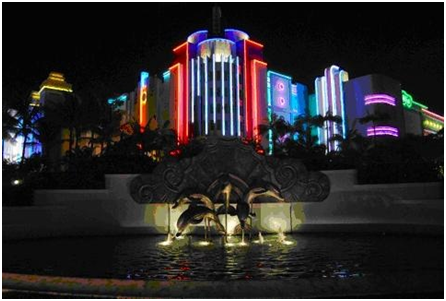 |
| SunCoast Casino. (Photo: KZN Tourism) |
Let’s start at the north end, right up next to the SunCoast Casino, with its cinemas, restaurants and grassy outdoor coffee bars. Okay, it’s garish and brash, but its fun.
Moving south, we pass the first of three lifesaving clubs, where nubile young things straight off the set of Baywatch ensure the safety of bathers. Next up, the skateboard park and bicycle hire shops, with the coffee-house ‘Circus-Circus’ right on the promenade. Its just as well the walk way is really, really wide here, because at any time of the day or early evening, and especially on Sundays, the walkway is filled with skaters and skateboarders, cyclists of all ages and sizes – cute kids on pink bikes and sleek athletes in full gear and helmets, making the most of the fresh air.
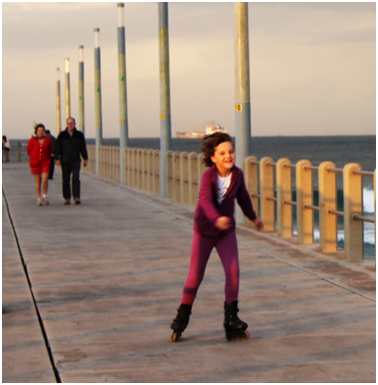 |
| Skating on the Pier. (Photo: Ruth Teer-Tomaselli) |
A little further down and we are in line with the revamped amphitheatre and the ‘old’ botanic gardens. First built during the 1930s, this area had a major revamp for the 2010 Soccer World Cup, and is now a really great open air landscape. The Elangeni and North Beach Hotels, where some of the delegates are staying, is right opposite this part of the beachfront.
Now we move down the centre of the beach front, where two circular building house restaurants, ice cream parlours and bars. Joe Cool’s advertises themselves as providing ‘The world’s worst food’, but then that’s not why we go there – we go for the great vibe and music, the outstanding ocean views and the excellent beers and cocktails. As for food – stick to burgers and chips and you won’t be disappointed.
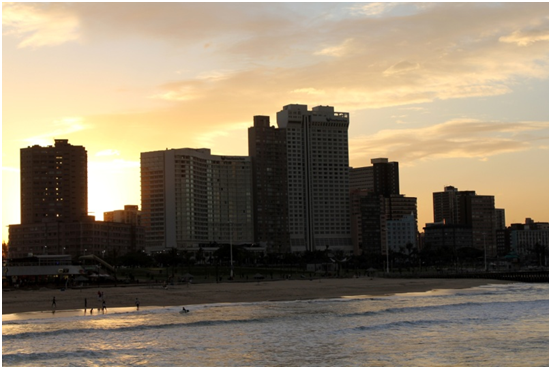 |
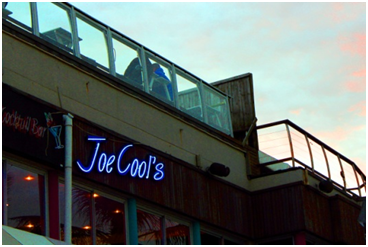 |
|
Elangeni and North Beach Hotels |
Joe Cool’s. (Photo: Ruth Teer-Tomaselli) |
All along the beachfront you will see rickshaw men, decked out in their traditional finery of Zulu beadwork and horned headdresses, pulling small carts for holiday-goers. Once there were more than 20,000 registered rickshaw pullers throughout the city, now there are only a handful of men who continue the tradition. A ride will cost you about R30.00 (more or less 3 euro), and a photograph with a rickshaw about half that. These beautifully hand made wagons are real treasures, passed down from father to son, and your custom is greatly appreciated.
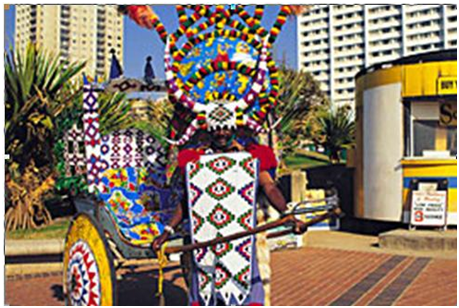 |
| Rickshaw puller in full regalia (Photo: KZN Tourism) |
Caption: Another unique beach attraction are the sand sculptors who create elaborate works of art, often life size, of animals, people, motor cars and villains for tourists to admire and have their photo taken with. These unique creations provide a living for enterprising people, and have become a star attraction on the beach front.
Walking further south, past the Rachel Finlayson swimming pool, which until the construction of the new Olympic size pool near the soccer and rugby stadia, were the largest pools in Durban, we get to the paddle pools – three huge, interlocked sea water pools used primarily by children. The amusement park with its bright lights, merry-go-rounds and cable car rides, fronts the Marine Parade Hotel, the second of our delegate hotels. The rounded edges and tiered front is homage to Durban’s art deco heritage, a theme that is echoed by a number of buildings facing the beachfront. Down a little further we get to the adventure park, right in front of the last of our hotels, South Beach. This area, which used to be regarded as a little ‘down market’, has really benefitted from the beach revamp, and is now seamlessly connected to the rest of the beachfront.
 |
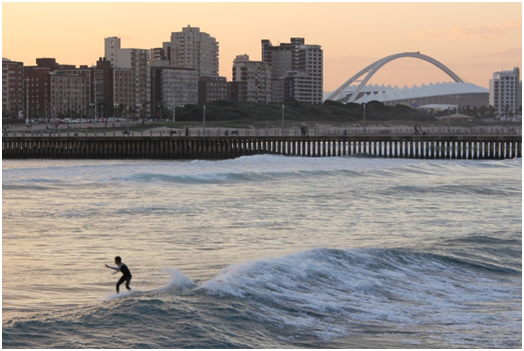 |
| It’s never too cold for ice cream! (Photo: Ruth Teer-Tomaselli) |
Evening surfer with Moses Madiba Stadium in the background. (Photo: Ruth Teer-Tomaselli) |
If you still have energy, you can continue to the end of the paved walkway down to UShaka Marine World. This is home not only a waterworld theme park, but to the FitzSimmons Snake Park, one of the best snake and reptile collections in the world. Adjacent is Moyo’s, where we will meet on Monday night for an authentic African dinner, complete with drumming, dancing, and Xhosa-face painting. If you find yourself at a lose end, you could do worse than sample Moyo’s most recent venture of an ‘African Tapas’ (read: delicious little bits of African specialities served in interesting ways) and cocktail bar, right on the end of a pier.
The entire beachfront is divided by piers, and they make great walking spots from which to view fishermen, courting couples and of course, the year-round Durban surfers.
So now it is time to turn back, and walk up north to where I parked my car. I love this walk!